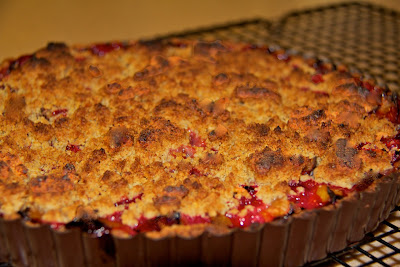It's not that all these recipes aren't delicious, because I am sure they are. But mostly I have found that many of my friends make their briskets just the way their mothers did. Let's face it, we all love what we know best. Unfortunately for me, my mother was no Julia Child, although she spent years feeding our family. I have absolutely no recollection of her brisket, other than it being a little on the tough side, and as such I have never sought to duplicate it. I am a woman without an inherited brisket recipe.
I have spent years and countless Jewish holidays trying to find my "best" brisket recipe. I'm talking about the recipe I teach my kids to make and the one that they proclaim as the best. As a result of my ongoing research, I've made dozens.
Just out of the oven
But, I have to tell you, this brisket was delicious. Its exotic Middle Eastern seasonings elevate the meat far beyond your standard gadempta brisket. It's probably not my go-to brisket, but it's certainly a recipe to make again. And who knows. Maybe one of my kids will proclaim this as the best.
Recipe: Braised Brisket With Pomegranate Juice, Chestnuts and Turnips
The New York Times, September 20, 2011
Adapted from Michael Solomonov, Zahav, Philadelphia
Ingredients:
1 brisket, about 4 to 5 pounds, with thin layer of fat
2 1/2 tablespoons coarse salt, plus more as needed
3 tablespoons finely ground coffee
1 teaspoon ground cardamom
1 to 2 tablespoons vegetable oil, if needed
2 onions, peeled and diced
2 large carrots, peeled and diced
1 bulb garlic, peeled and halved
1 pound (3 to 4 medium) turnips, peeled and quartered
1 tablespoon ground cumin
1 tablespoon black pepper
1 tablespoon ground turmeric
1 fresh licorice root (available in Middle Eastern markets) or 1 licorice tea bag (available at health food stores and some supermarkets)
4 cups pomegranate juice
1 cup peeled chestnuts (roasted, frozen or vacuum-packed)
1/2 cup chopped dill
1 cup chopped flat-leaf parsley.
Directions:
Place the brisket in a shallow roasting pan fat side up; add 2 1/2 tablespoons salt, the coffee and cardamom; and rub all over the brisket. Cover lightly with foil and refrigerate for two days
Preheat a broiler. Place the pan with the brisket under it until the meat is evenly browned and much of the fat rendered, about 15 minutes. Remove, transfer brisket to a platter and turn oven to 300 degrees.
Pour the fat into a Dutch oven or other heavy covered pan large enough to hold the brisket. There should be about 1/4 cup fat; if needed, add vegetable oil. Place the pan over medium-high heat, and add onions, carrots, garlic and a pinch salt. Sauté until lightly browned, about 10 minutes. Add turnips, cumin, black pepper and turmeric. Cover and cook, stirring once or twice, for 5 minutes.
Add licorice or licorice tea bag, and pomegranate juice. Stir, scraping the bottom of the pan. Add brisket, bring to a simmer, and baste with the juice.
Cover the pan tightly and place on the middle rack in the oven. Cook until very tender, about 4 hours, basting every 45 minutes. Remove from the oven and discard licorice or tea bag and garlic halves. If desired, at this point, cool the brisket and vegetables, cover, and refrigerate overnight.
Just before serving, skim the fat and place the pan over medium-low heat. Add chestnuts and reheat just until steaming. Stir in dill and parsley. Transfer brisket to a cutting board and slice against the grain. Serve with vegetables and sauce.
Yield: 8 servings.













































